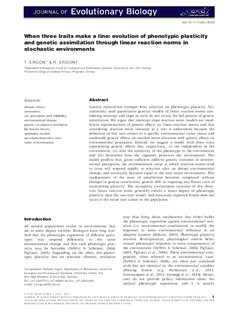| dc.contributor.author | Ergon, Torbjørn | |
| dc.contributor.author | Ergon, Rolf | |
| dc.date.accessioned | 2017-02-27T13:30:13Z | |
| dc.date.accessioned | 2017-04-19T12:50:13Z | |
| dc.date.available | 2017-02-27T13:30:13Z | |
| dc.date.available | 2017-04-19T12:50:13Z | |
| dc.date.issued | 2016 | |
| dc.identifier.citation | Ergon,T. & Ergon, R. (2016). When three traits make a line: evolution of phenotypic plasticity and genetic assimilation through linear reaction norms in stochastic environments. Journal of Evolutionary Biology . 1-15. | |
| dc.identifier.issn | 1010-061X | |
| dc.identifier.uri | http://hdl.handle.net/11250/2438477 | |
| dc.description.abstract | Genetic assimilation emerges from selection on phenotypic plasticity. Yet, commonly used quantitative genetics models of linear reaction norms con- sidering intercept and slope as traits do not mimic the full process of genetic assimilation. We argue that intercept–slope reaction norm models are insuf- ficient representations of genetic effects on linear reaction norms and that considering reaction norm intercept as a trait is unfortunate because the definition of this trait relates to a specific environmental value (zero) and confounds genetic effects on reaction norm elevation with genetic effects on environmental perception. Instead, we suggest a model with three traits representing genetic effects that, respectively, (i) are independent of the environment, (ii) alter the sensitivity of the phenotype to the environment and (iii) determine how the organism perceives the environment. The model predicts that, given sufficient additive genetic variation in environ- mental perception, the environmental value at which reaction norms tend to cross will respond rapidly to selection after an abrupt environmental change, and eventually becomes equal to the new mean environment. This readjustment of the zone of canalization becomes completed without changes in genetic correlations, genetic drift or imposing any fitness costs of maintaining plasticity. The asymptotic evolutionary outcome of this three- trait linear reaction norm generally entails a lower degree of phenotypic plasticity than the two-trait model, and maximum expected fitness does not occur at the mean trait values in the population | |
| dc.language.iso | eng | |
| dc.subject | climate effects | |
| dc.subject | constraints | |
| dc.subject | cue perception and reliability | |
| dc.subject | environmental change | |
| dc.subject | genetic covariance/correlation | |
| dc.subject | life history theory | |
| dc.subject | optimality models | |
| dc.subject | unceriatin/imperfect cues | |
| dc.subject | value of information | |
| dc.title | When three traits make a line: evolution of phenotypic plasticity and genetic assimilation through linear reaction norms in stochastic environments | |
| dc.type | Journal article | |
| dc.type | Peer reviewed | |
| dc.description.version | Published version | |
| dc.identifier.doi | 10.1111/jeb.13003 | |
